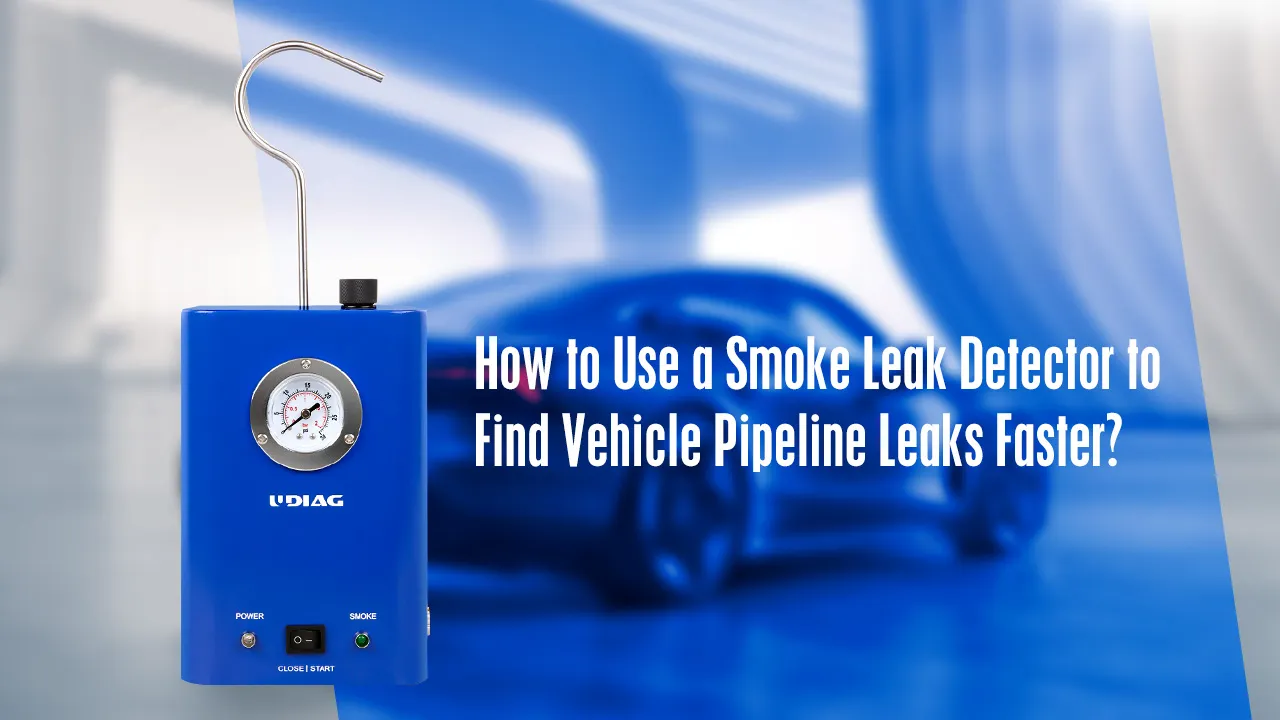How to Use a Smoke Leak Detector to Find Vehicle Pipeline Leaks Faster
2025-07-29 by UDIAG

Introduction:
Leaks in vehicle lines, whether they are in the intake system, exhaust system, evaporative exhaust system or vacuum line, can be a huge headache for technicians and repair shops. Traditional leak detection methods are time-consuming and often unreliable. That’s why more and more professionals are turning to smoke leak detectors to quickly and accurately identify even the smallest leaks.
In this blog, we’ll show you how to use a smoke leak detector, why it can improve diagnostic efficiency, and what to consider when choosing a smoke leak detector for your auto body shop or workshop.
What Is a Smoke Leak Detector?
A smoke leak detector is a diagnostic tool that generates visible smoke to help locate leaks in vehicle systems. It uses a special fluid (usually mineral oil or OEM-approved smoke fluid) that is vaporized and pumped into the suspected pipeline system. If there’s a leak, the smoke will visibly escape through the damaged area, making detection quick and visual.
This tool is especially helpful for diagnosing:
- EVAP system leaks
- Intake manifold leaks
- Vacuum line issues
- Exhaust system leaks
- Turbo system leaks
Benefits of Using a Smoke Leak Detector
Using a smoke leak detector in your repair process offers a range of benefits:
- Quick Detection: Pinpoint the leak within minutes without guesswork.
- Visual Proof: Easy to see smoke escaping from the exact location.
- Time-Saving: Reduces diagnostic time significantly compared to traditional methods.
- Cost-Effective: Helps prevent unnecessary part replacements and customer callbacks.
- Versatile Application: Suitable for both gasoline and diesel vehicles.
Step-by-Step Guide: How to Use a Smoke Leak Detector
Follow these steps to find vehicle pipeline leaks faster and more efficiently:
Prepare the Vehicle
- Turn off the engine and ensure the system is cool.
- Disconnect the system or component you suspect has a leak.
- Seal any open ports or vents to contain the smoke during the test.
Connect the Smoke Leak Detector
- Attach the detector’s smoke hose to the system’s test port or an open vacuum line.
- Make sure the connection is secure and sealed tightly.
Start the Smoke Test
- Turn on the smoke leak detector and let it begin generating smoke.
- Pump the smoke into the system for several seconds until it’s pressurized.
Inspect for Leaks
- Observe the system for visible smoke leaks.
- Use a bright flashlight if necessary to inspect hard-to-see areas.
- Pay close attention to connectors, hoses, gaskets, and plastic lines.
Confirm and Repair
- Once a leak is located, mark the area.
- Perform the necessary repair and re-test to ensure the leak is fully resolved.
Tips for Faster and More Accurate Leak Detection
- Use UV-Enhanced Smoke: Some smoke leak detectors produce UV-visible smoke, allowing leaks to be seen even in poorly lit areas.
- Maintain Proper Pressure: Don’t over-pressurize the system—follow the manufacturer’s recommended settings.
- Regular Maintenance: Keep the smoke machine clean and use high-quality smoke fluid to ensure consistent performance.
Choosing the Right Smoke Leak Detector for Your Workshop
When selecting a smoke leak detector, consider the following features:
- Adjustable pressure control
- Built-in air pump (vs. needing an external compressor)
- Oil level indicator
- Safety protection (such as overheat protection)
- Wide compatibility (EVAP, turbo, intake, etc.)
- Fast warm-up time
The ALT300 smoke leak detector from UDIAG features all the above advantages. It is compact in size, lightweight, easy to carry and occupies the least space.
Final Thoughts
A smoke leak detector is a must-have diagnostic tool for any modern automotive repair shop. By allowing technicians to quickly locate and confirm leaks in pipelines, it boosts efficiency, reduces labor time, and improves customer satisfaction.
If you’re ready to upgrade your diagnostic tools, explore our range of professional-grade smoke leak detectors designed for all vehicle types and workshop needs.


